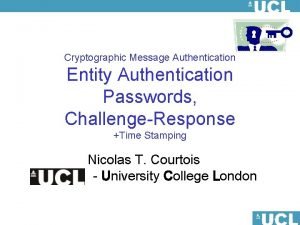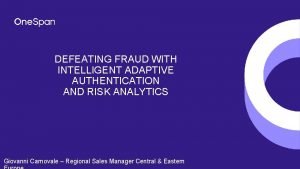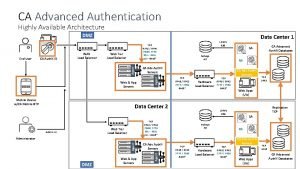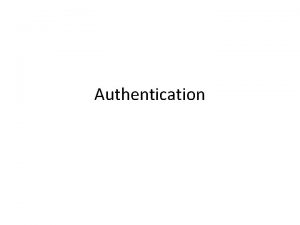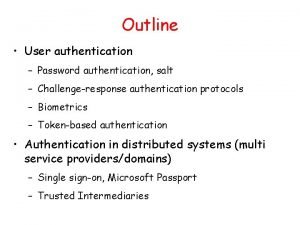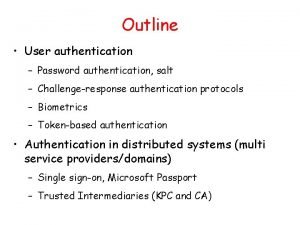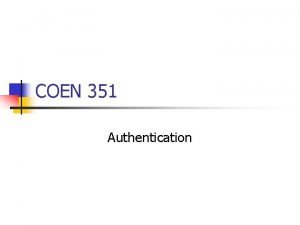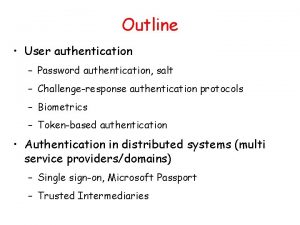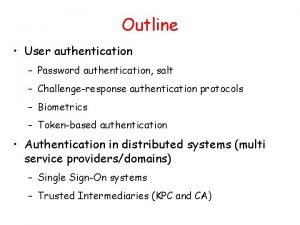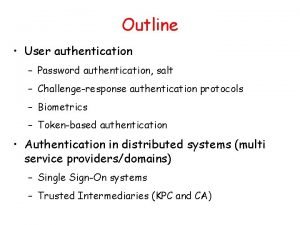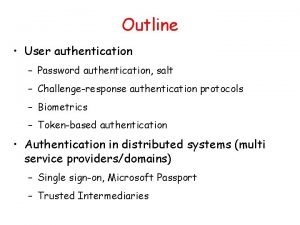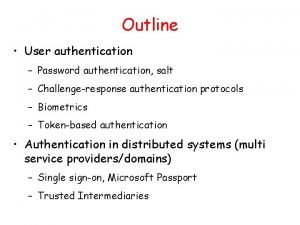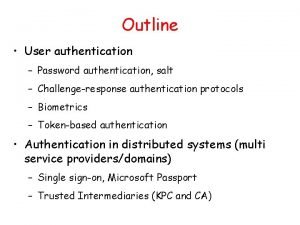Authentication Definition Authentication is the process of validating













- Slides: 13

Authentication

Definition Authentication is the process of validating the identity of someone or something. Generally authentication requires the presentation of credentials or items of value to really prove the claim of who you are. The items of value or credential are based on several unique factors that show something you know, something you have, or something you are 2

– Something you know: This may be something you mentally possess. This could be a password, a secret word known by the user and the authenticator. – Something you have: This may be any form of issued or acquired self identification such as: Secur. ID Crypto. Card Activcard Safe. Word and many other forms of cards and tags. – Something you are: This being a naturally acquired physical characteristic such as voice, fingerprint, iris pattern and other biometrics. – In addition to the top three factors, another factor, though indirect, also plays a part in authentication. Somewhere you are: This usually is based on either physical or logical location of the user. The use, for example, may be on a terminal that can be used to access certain resources. 3

In general authentication takes one of the following three forms: – Basic authentication involving a server. The server maintains a user file of either passwords and user names or some other useful piece of authenticating information. This information is always examined before authorization is granted. – Challenge-response, in which the server or any other authenticating system generates a challenge to the host requesting for authentication and expects a response. – Centralized authentication, in which a central server authenticates users on the network and in addition also authorizes and audits them. 4

Multiple Factors and Effectiveness of Authentication To increase authentication effectiveness, a scheme with multiple methods is used. Systems using a scheme with two or more methods can result in greater system security The popular technique, referred to as multi -factor authentication, overcome the limitations of a specific authentication. 5

Authentication Elements An authentication process as is based on the following five elements: – Person or Group Seeking Authentication - usually users who seek access to a system either individually or as a group. If individually, they must be prepared to present to the authenticator evidence to support the claim that they are actually authorized to use the requested system resource. – Distinguishing Characteristics for Authentication User characteristics are grouped into four factors that include: something you know, something you have, something you are, and a weaker one somewhere you are. In each of these factors, there are items that a user can present to the authenticator for authorization to use the system. 6

– The Authenticator - to positively and sometimes automatically identify the user and indicate whether that user is authorized to access the requested system resource. – The Authentication Mechanism - consists of three parts that work together to verify the presence of the authenticating characteristics provided by the user. the input, the transportation system, and the verifier. – Access Control Mechanism - User identifying and authenticating information is passed to access control from the transport component. That information is validated against the information in its database residing on a dedicated authentication server, if the system operates in a network, or stored in a file on a local medium. 7

Types of Authentication There are two basic types of authentication. nonrepudiable and repudiable. Other types of authentication include user, client, and session authentication. – Non-repudiable Authentication - involves characteristics whose proof of origin cannot be denied. Such characteristics include biometrics like iris patterns, retinal images, and hand geometry and they positively verify the identity of the individual. – Repudiable Authentication – involves factors, “what you know” and “what you have, ” that can present problems to the authenticator because the information presented can be unreliable because such factors suffer from several wellknown problems including the fact that possessions can. Kizzabe lost, forged, or easily 8 - Guide to Computer Network Security duplicated.

Authentication Methods There are several authentication methods including: password, public-key, anonymous, remote and certificatebased authentication. – Password authentication - the oldest and the easiest to implement. It includes reusable passwords, one-time passwords, challenge response passwords, and combined approach passwords. – Public Key Authentication – This requires each user of the scheme to first generate a pair of keys and store each in a file. Each key is usually between 1024 and 2048 bits in length. Public-private keys pairs are typically created using a key generation utility. The server knows the user's public key because it is published widely. However, only the user has the private key. 9

– Anonymous Authentication - Clients who do not intend to modify entries or access protected attributes or entries on a system typically use anonymous authentication. Mostly these users are not indigenous users in a sense that they do not have membership to the system they want access to. They access the system via a special “anonymous” account. – Digital Signatures-Based Authentication – is an authentication technique that does not require passwords and user names. It consists of an electronic signature that uses public key infrastructure (PKI) to verify the identity of the sender of a message or of the signer of a document. The scheme may include a number of algorithms and functions including the Digital Signature Algorithm (DSA), Elliptic Curve Digital Signature and Algorithm (ECDSA), account authority digital signature, authentication function, and signing function. 10

– Wireless Authentication –This is an IEEE’s 802. 1 X, Extensible Authentication Protocol (WEP) scheme that authenticates mobile devices as they connect to fixed network as well as mobile networks. This authentication requires Wi-Fi mobile units to authenticate with network operating systems such as Windows XP. 11

Developing an Authentication Policy In many organizations the type of authentication used is not part of the security policy, therefore, few have a say in what authentication policy is used. It is becoming increasingly popular to involve as wide a spectrum of users in the development of the authentication policy. Sometimes it even requires input from business and IT representative communities that do business with the organization. This is sometimes key to ensuring acceptance and compliance by those communities. Several steps are necessary for a good authentication policy: 12

– List and categorize the resources that need to be accessed, whether these resources are data or systems. Categorize them by their business sensitivity and criticality. – Define the requirements for access to each of the above categories taking into account both the value of the resource in the category as well as the method of access. – Set requirements for passwords and IDs. – Create and implement processes for the management of authentication systems. – Communicate policies and procedures to all concerned in the organizations and outside it. The creation of policies 13


